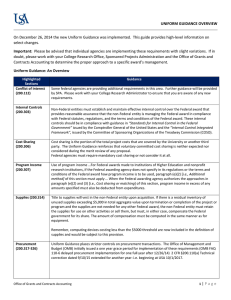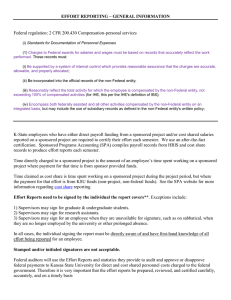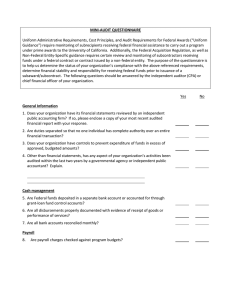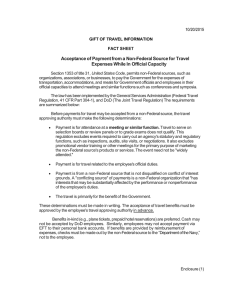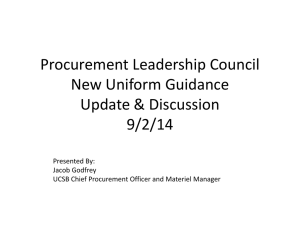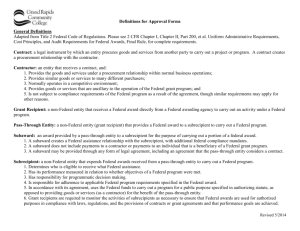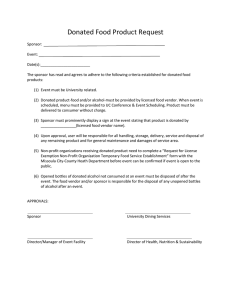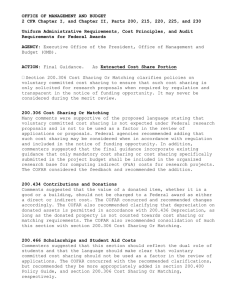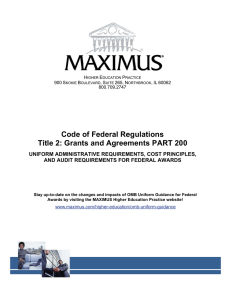EASTERN MICHIGAN UNIVERSITY Sponsored Research Accounting Cost Share Guidelines
advertisement
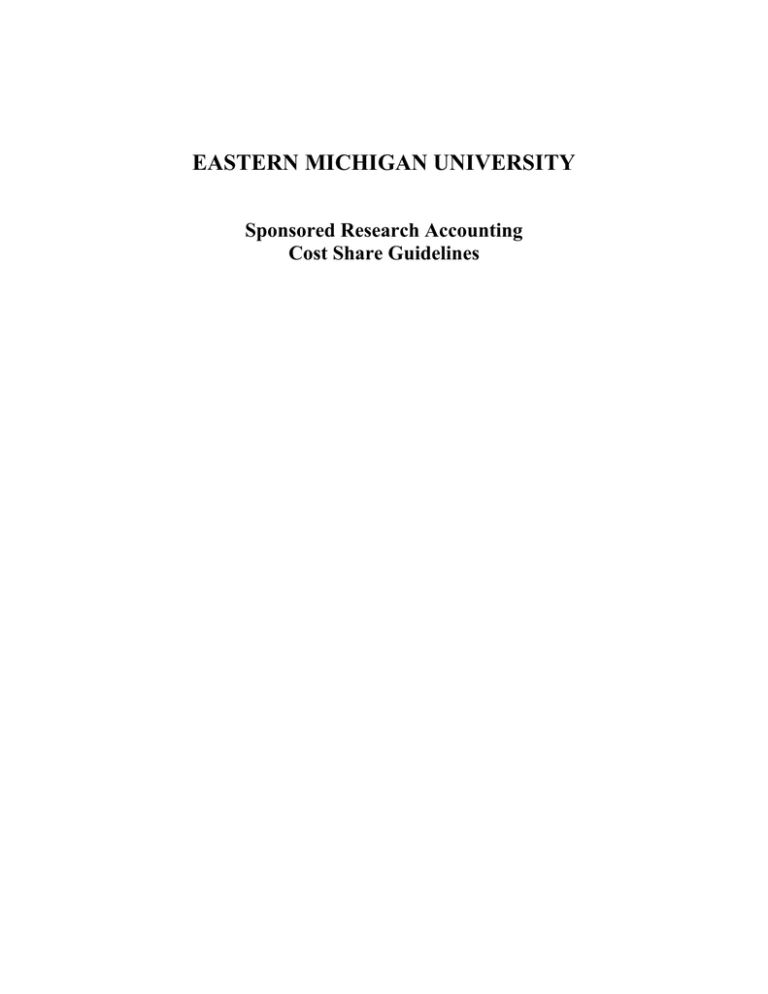
EASTERN MICHIGAN UNIVERSITY Sponsored Research Accounting Cost Share Guidelines PURPOSE: The purpose for the Cost Share Guidelines is to articulate the roles and responsibilities of the various parties and offices in how to fund and account for expenses committed as cost share associated with a specific sponsored award. Following the procedures set forth in this document ensures that Eastern Michigan University satisfies its commitment and reporting requirements to its sponsors. DEFINITION OF COST SHARE: §200.49 of the Uniform Guidance defines cost share as “Cost sharing or matching means the portion of project costs not paid by Federal funds (unless otherwise authorized by Federal statute). See also §200.306 Cost sharing or matching.” Cost share is the financial support that EMU agrees to contribute in order to further the research/service performed within the agreement between EMU and sponsor. Cost share can be mandated by the sponsor or we can voluntarily commit cost share to be spent as part of the award. Cost share funds must be spent proportionately to the sponsor funds. (e.g. if you only spend 50% of the sponsor awarded funds, it is reasonable to expect you only need to meet 50% of your cost share commitment.) For more information pertaining to the budgeting of cost share, please see the ORDA Cost Sharing Policy. FUNDING: When cost share is required (mandatory, voluntary-committed, or voluntary), a C-fund will be established with the corresponding R-fund (sponsor funded portion). The primary responsibility for cost sharing rests with the academic unit. However, the Office of Research Development and Administration ("ORDA") may be able to supplement academic unit cost sharing when necessary to meet sponsor requirements. Whether funding is coming from an academic department or ORDA, Sponsored Research Accounting will process a journal transfer (JV), using transfer account codes, when the C-fund is first established. This JV will “charge” the FOAP providing the funding and “credit” the new C-fund (similar to how revenue would work for an R-fund). The actual expenses associated with this funding will be applied directly to the C-fund. Any funding that came from a general fund FOAP that goes unused, and are not required to be spent, will be transferred back to the University’s general fund. ALLOWABLE EXPENSES: Allowable cost share expenses can be any incurred expense related to the award agreement. This can be a direct expense (these expenses must be charged directly to the C-fund assign to the award), unrecovered indirect cost (if applicable and approved by the sponsor and EMU), and in-kind expenses (e.g. documented goods or services donated to the University by an outside vendor). The Uniform Guidance (CFR 200.306) states the following regarding cost sharing or matching: (a) Under Federal research proposals, voluntary committed cost sharing is not expected. It cannot be used as a factor during the merit review of applications or proposals, but may be considered if it is both in accordance with Federal awarding agency regulations and specified in a notice of funding opportunity. Criteria for considering voluntary committed cost sharing and any other program policy factors that may be used to determine who may receive a Federal award must be explicitly described in the notice of funding opportunity. See also §§200.414 Indirect (F&A) costs, 200.203 Notices of funding opportunities, and Appendix I to Part 200—Full Text of Notice of Funding Opportunity. (b) For all Federal awards, any shared costs or matching funds and all contributions, including cash and third party in-kind contributions, must be accepted as part of the non-Federal entity's cost sharing or matching when such contributions meet all of the following criteria: (1) Are verifiable from the non-Federal entity's records; 2) Are not included as contributions for any other Federal award; 3) Are necessary and reasonable for accomplishment of project or program objectives; 4) Are allowable under Subpart E—Cost Principles of this part; 5) Are not paid by the Federal Government under another Federal award, except where the Federal statute authorizing a program specifically provides that Federal funds made available for such program can be applied to matching or cost sharing requirements of other Federal programs; (6) Are provided for in the approved budget when required by the Federal awarding agency; and (7) Conform to other provisions of this part, as applicable. (c) Unrecovered indirect costs, including indirect costs on cost sharing or matching may be included as part of cost sharing or matching only with the prior approval of the Federal awarding agency. Unrecovered indirect cost means the difference between the amount charged to the Federal award and the amount which could have been charged to the Federal award under the non-Federal entity's approved negotiated indirect cost rate. (d) Values for non-Federal entity contributions of services and property must be established in accordance with the cost principles in Subpart E—Cost Principles. If a Federal awarding agency authorizes the non-Federal entity to donate buildings or land for construction/facilities acquisition projects or long-term use, the value of the donated property for cost sharing or matching must be the lesser of paragraphs (d) (1) or (2) of this section. (1) The value of the remaining life of the property recorded in the non-Federal entity's accounting records at the time of donation. (2) The current fair market value. However, when there is sufficient justification, the Federal awarding agency may approve the use of the current fair market value of the donated property, even if it exceeds the value described in (1) above at the time of donation. (e) Volunteer services furnished by third-party professional and technical personnel, consultants, and other skilled and unskilled labor may be counted as cost sharing or matching if the service is an integral and necessary part of an approved project or program. Rates for third-party volunteer services must be consistent with those paid for similar work by the non-Federal entity. In those instances in which the required skills are not found in the non-Federal entity, rates must be consistent with those paid for similar work in the labor market in which the non-Federal entity competes for the kind of services involved. In either case, paid fringe benefits that are reasonable, necessary, allocable, and otherwise allowable may be included in the valuation. (f) When a third-party organization furnishes the services of an employee, these services must be valued at the employee's regular rate of pay plus an amount of fringe benefits that is reasonable, necessary, allocable, and otherwise allowable, and indirect costs at either the third-party organization's approved federally negotiated indirect cost rate or, a rate in accordance with §200.414 Indirect (F&A) costs, paragraph (d), provided these services employ the same skill(s) for which the employee is normally paid. Where donated services are treated as indirect costs, indirect cost rates will separate the value of the donated services so that reimbursement for the donated services will not be made. (g) Donated property from third parties may include such items as equipment, office supplies, laboratory supplies, or workshop and classroom supplies. Value assessed to donated property included in the cost sharing or matching share must not exceed the fair market value of the property at the time of the donation. (h) The method used for determining cost sharing or matching for third-party-donated equipment, buildings and land for which title passes to the non-Federal entity may differ according to the purpose of the Federal award, if paragraph (h)(1) or (2) of this section applies. (1) If the purpose of the Federal award is to assist the non-Federal entity in the acquisition of equipment, buildings or land, the aggregate value of the donated property may be claimed as cost sharing or matching. (2) If the purpose of the Federal award is to support activities that require the use of equipment, buildings or land, normally only depreciation charges for equipment and buildings may be made. However, the fair market value of equipment or other capital assets and fair rental charges for land may be allowed, provided that the Federal awarding agency has approved the charges. See also §200.420 Considerations for selected items of cost. (i) The value of donated property must be determined in accordance with the usual accounting policies of the non-Federal entity, with the following qualifications: (1) The value of donated land and buildings must not exceed its fair market value at the time of donation to the non-Federal entity as established by an independent appraiser (e.g., certified real property appraiser or General Services Administration representative) and certified by a responsible official of the non-Federal entity as required by the Uniform Relocation Assistance and Real Property Acquisition Policies Act of 1970, as amended, (42 U.S.C. 4601-4655) (Uniform Act) except as provided in the implementing regulations at 49 CFR part 24. (2) The value of donated equipment must not exceed the fair market value of equipment of the same age and condition at the time of donation. (3) The value of donated space must not exceed the fair rental value of comparable space as established by an independent appraisal of comparable space and facilities in a privately-owned building in the same locality. (4) The value of loaned equipment must not exceed its fair rental value. (j) For third-party in-kind contributions, the fair market value of goods and services must be documented and to the extent feasible supported by the same methods used internally by the non-Federal entity. (k) For IHEs, see also OMB memorandum M-01-06, dated January 5, 2001, Clarification of OMB A-21 Treatment of Voluntary Uncommitted Cost Sharing and Tuition Remission Costs.” (REF: http://www.ecfr.gov/cgi-bin/textidx?SID=ed90f54836feb6a994f657188eb05e33&node=2:1.1.2.2.1&rgn=div5) CLOSE-OUT PROCEDURE: The C-fund will be closed within the same time frame as the associated R-fund and the sponsor’s guidelines. If cost share funding was not fully spent for any reason and we are not obligated to complete our commitment (e.g. sponsor funds were not fully spent, so the cost share funds are spent in the same proportion), the unspent funds will be transferred to the University’s general fund when crossing over multiple fiscal years. Otherwise, it will be proportionately returned to the original FOAP(s) that funded the C-fund.
